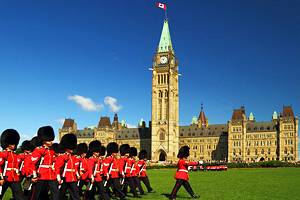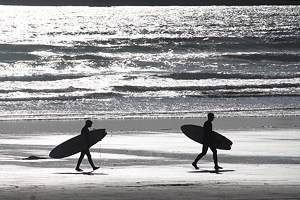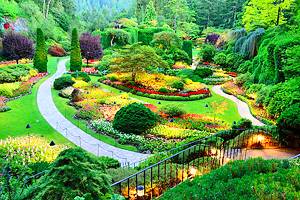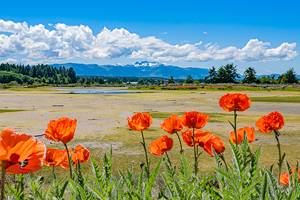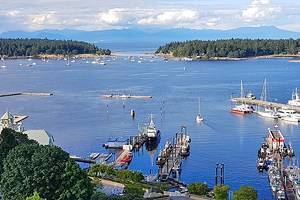Beaches in Tofino
Authors Michael and Lana Law lived in British Columbia and always enjoy returning to Tofino.
Tofino is home to the best beaches in Canada. The beaches are one of the main reasons people visit Tofino.
Wide-open expanses of sand front the Pacific Ocean and attract surfers and vacationers throughout the year. Wonderful and wild, each beach has its own personality depending on the day and time of year. Tofino's beaches may be rough and stormy, calm and placid, rainy, foggy, or windblown and lonely. It all depends on the whims of the Pacific Ocean, the massive body of water that stretches uninterrupted from here to Japan.
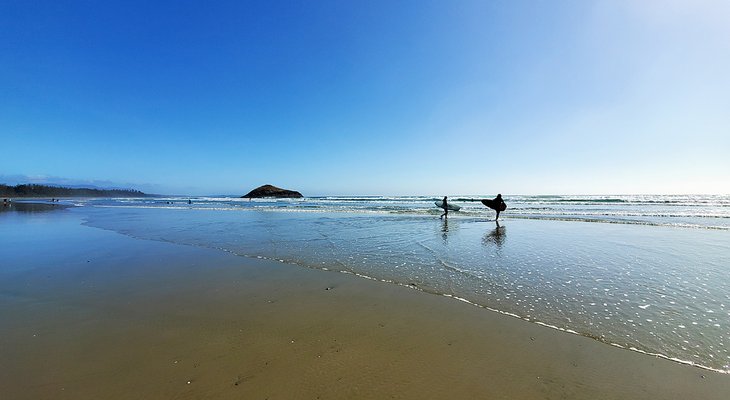
These beautiful stretches of sand are exceptionally easy to access; in most cases just park your car and walk 100 meters (or less). Things to do on Tofino's beaches include everything from surfing, swimming, going for long romantic walks, biking, shell hunting, and playing with your dog right through to just relaxing and staring out at the waves.
The best way to fully experience the area is to stay at a waterfront resort or lodge. That way you'll be able to see the beach as it changes throughout the day from sunrise to sunset.
Discover the best places with our list of the top beaches in Tofino.
Cox Bay Beach

Cox Bay is one of the liveliest stretches of beach near Tofino. A significant number of Tofino's top resorts and one of the newest campgrounds line this beach, and the guests staying here can make full use of the waterfront locations.
Surfers love this beach because the narrow opening of Cox Bay amplifies the size of the ocean rollers. Even if you aren't into watersports, this is a great beach to just sit back and watch the non-stop action of the waves.
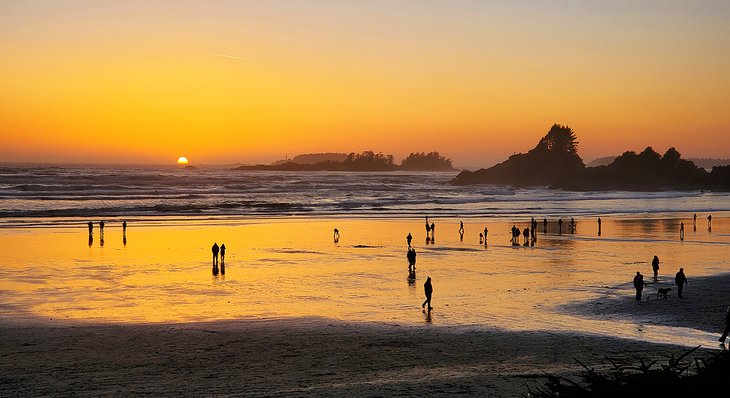
One of the great benefits of this beach is the services available. Want to learn how to surf? Surfboard rentals and instruction are available at the surf school located in the Pacific Sands Beach Resort complex. Don't feel like cooking tonight? Catch a beautiful sunset dinner in the Great Room at Long Beach Lodge, or stop in at the Sandbar bistro.
At the south end of the beach is a rocky headland that makes for interesting exploring at low tide. Photographers will love the sunsets over Frank Island taken from the beach or from the area near the benches on Sunset Point (up on the rocks at the north end of the beach).
Long Beach

Long Beach is the most famous of all the beaches near Tofino — and for good reason. The sheer majesty of the open space fronting the ocean does strange things to your mind and can make you feel small and even a bit vulnerable.
This huge beach is the largest beach on Vancouver Island, stretching for 16 kilometers, and actually includes Combers and Wickaninnish beaches. There is some debate as to whether Florencia Bay is also part of Long Beach, it depends on who you speak to.
Long Beach has distinct personalities depending on where you access it. Some areas, like near the main parking lots and Incinerator Rock, are busy, but Combers Beach is generally very quiet with few people around, and Wickaninnish is more popular due to the Kwisitis Visitor Centre.
If you love beach walking, this is the place to do it - the flat sands make for a great walking surface, and you'll have to ford very few streams crossing the beach. One great route from the main parking lot is to head north to Schooner Bay, where you can walk to Box Island at low tide. In fact, the beach is so long that some people choose to bring their mountain bikes and pedal along the hard-packed sands.

Always a popular spot for surfers, the non-stop waves at Long Beach can get quite large. Just offshore, Incinerator Rock has an interesting history relating to WWII, and it makes for a great photo subject, as the surfers in the foreground provide perspective on how large the scene is.
Two large parking lots accommodate plenty of cars, and space for RVs is set aside. In the parking area, just back from the beach, are changerooms, showers, and modern comfort stations. Access to the beach is via a short, relatively level walkway. You may need to step over some logs at the entrance to the beach.
Chesterman Beach

Chesterman Beach is one of the more popular beaches in Tofino owing to its great waves. Just over the headland south of MacKenzie Beach, this spot has a fun atmosphere. This is the closest beach to Tofino (apart from Tonquin Beach in town) and is popular with locals and people staying in hotels located off the beach. It's usually packed with families and groups.
Chesterman Beach is generally divided into North Chesterman and South Chesterman. It has a unique "A" shape, with the point of the "A" being Frank Island. The island is only reachable during low tide when a sandy land bridge emerges from the water. This area also has some interesting tidal pools worth checking out. Many people choose to make this their primary go-to beach because no park pass is required, and parking is free.

The back of the beach is primarily lined with private residences, some of which operate as bed and breakfasts. At the far northern end of the beach is the high-end Wickaninnish Inn, which despite its name is not actually located on Wickaninnish Beach. The actual beach is located many kilometers to the south of this location.
Mackenzie Beach
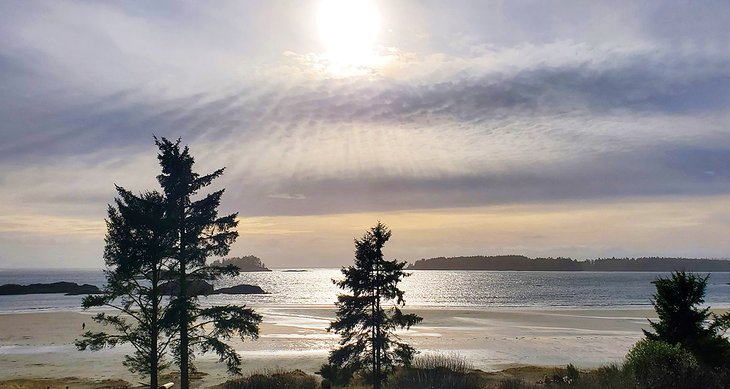
Mackenzie Beach is one of the smaller beaches along the coast but one of the calmest and most enjoyable. The beach is very well protected by offshore islands, so it's not a popular surfing spot; however, some smaller waves do roll in, and it's a good place to play in the water.
Interesting headlands are available at either end. At low tide, the southern end of the beach joins up with the island offshore, and this temporary walkway is protected from the wind and is a fascinating place to explore.

McKenzie Beach is a great photo spot. An array of offshore islands make for great subjects juxtaposed against the big ocean and sky backgrounds.
Multiple hotels line the beach, and staying here gives you easy access to the water. Restaurants and other services, including surfboard rentals and lessons along with bike rentals, are easily arranged at the Best Western Plus Tin-Wis Resort. A short stroll inland from the beach at the southern end brings you to a retail area off the main highway where you'll find food trucks, a chocolate shop, cafés, and other services.
Florencia Bay Beach

Florencia Bay takes a bit of effort to get to, but once you're here, you'll be glad you went. Reached via a narrow road, a short trail, and a set of steep stairs, the beach has a much different feel than all the others. No resorts or homes line this beach, and with the steep shoreline backed by large trees, it has a very raw, untouched feel to it.
Florencia Bay is more of a locals' beach hideout than the more popular destinations, perhaps owing to its off-the-beaten-track location. As a result, the vibe here is very relaxed and quiet. You'll see groups of people hanging out in the driftwood catching up on the local gossip while scanning the surf for the next set of big rollers.

Bring your camera, this is also where you'll see some of the best local surfers riding the huge surf past the river mouth at the south end of the beach. The beach is a good spot for a walk although be aware that the route to the south does require fording a relatively large stream that crosses the beach.
The parking lot for Florencia Bay is quite small; RVs of any sort are prohibited.
Wickaninnish Beach

Wickaninnish Beach is a wild expanse of beach with windswept shorelines. Located at the southern end of Long Beach, Wickaninnish showcases a different side of Tofino's most famous beach. Here, the shoreline is scrubby, with small bushes tortured by the strong winds. Pushed up against the back of the beach is an incredible amount of driftwood and large logs.
If you crave solitude, just start walking north. Before too long, your only company will be the crashing waves, wind, and if you are lucky, a passing sea lion. Although some people surf here, it's a dangerous place to be in the ocean. Strong rip currents are the norm, and the rocks at the southern end are jagged and deadly.
At the south end of the beach, where most people go, is the Kwisitis Visitor Centre. Perched perfectly on a peninsula of land, this marquee heritage building is a treasure trove of information on the ocean, surrounding areas, and First Nations. For incredible views up and down the coast, step out onto the patio that extends over the rocks. Parks Canada has extensive renovation and upgrades planned for the Kwisitis Visitor Centre.
Tonquin Beach

If you are staying in town and crave a bit of beach time, take the short stroll down through the rainforest to Tonquin Beach. It is far and away the smallest beach in the region, and what it lacks in size, it more than makes up for in appearances.
Spread over two coves with steep, rocky backdrops and a small island in between, Tonquin is simply stunning. Small ravines running back from the beach are perfect for exploration and unique photos. Views out from the beach are to Wickaninnish Island and the Pacific beyond.

If you feel the need to go for a swim or just want to dip your toes in the Pacific Ocean just to say you've done it, this is the place to make that happen. The beach is on a channel, and as a result has very few waves and crystal-clear water, perfect for wading. It's best to visit this beach at or near low tide; otherwise, you won't be able to see much.
Two trails lead to Tonquin Beach: One leaving from the community center at the end of Arnet Road is longer, but you'll have a better chance of getting parking. The other trail leaves from the parking lot at the end of Tonquin Park Road and is much more direct. Both trails involve stairs and boardwalks, are well-maintained, and are suitable for anyone.
Combers Beach

For a truly lonely British Colombia beach with very few people around, make the trek to Combers Beach. This beach, actually a portion of the aforementioned Long Beach, seems to collect the largest quantity of driftwood and logs of all the local coastal beaches. Combers Beach is almost completely flat, meaning that if you arrive at low tide, you'll have a surprisingly long walk to the water's edge.
A large stream blocks access to the southern portion of the beach unless you choose to ford it. If you head northward, it won't be long before you'll be the only human on the beach. If you walk long enough and get to Green Point, you might come across a person or two that has descended from the park campground.
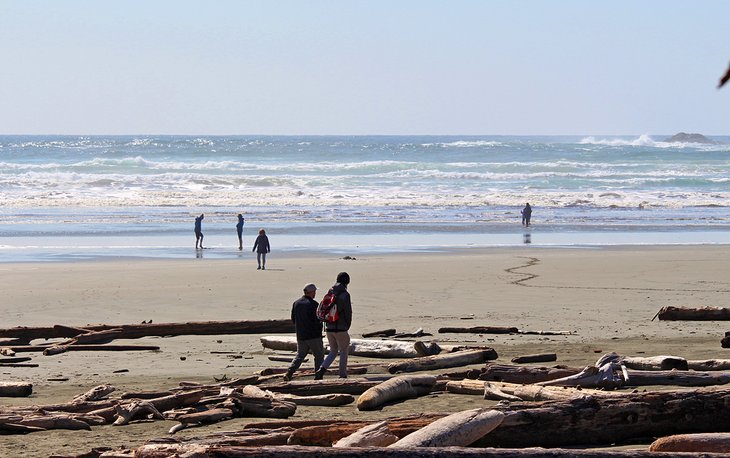
Reached via a 0.5-kilometer trail and boardwalk, the beach is accessible to anyone with a moderate ability of fitness. The trail descends gently towards the ocean while passing large trees. Eventually, you'll cross a boardwalk and emerge at the ocean, where you'll need to step down about a meter to the sand.
Schooner Beach

All the beaches in Tofino are spectacular in their own way, and Schooner Beach is no exception to that rule. Set in Schooner Bay, this beach is a long arc of flat brown sand with a few small islands along the beach and just offshore, the much larger Box Island.
This beach used to be relatively busy, as the very popular Schooner Cove Trail led down through the Old Growth forest to the seashore; however, the trail has been closed for many years with no firm reopening date. As a result, the beach is usually completely deserted, and if you seek solitude without a long drive from Tofino, this is the place to come.
The shoreline has extensive piles of driftwood, perfect for finding the ideal walking stick or souvenir piece. The islands along the shore are rocky and home to all kinds of marine creatures, providing endless opportunities for exploration by children or those young at heart.
The beaches of Tofino can frequently be windy. If that's the case during your visit, head to Schooner Beach. Its location is relatively protected from the predominant breezes.
One thing to note, due to the trail closure, Schooner Beach can only be reached when the tide is out, as you'll need to walk from the northern end of Long Beach around a point to get there.
Map of Beaches in Tofino
When is the best time to go to the beach in Tofino?
The best time for beaching in Tofino is actually September. At this time the water is warm(ish), the sun shines pretty consistently, and the winds that typically howl most summer afternoons from noon onwards stop. You'll also see fewer visitors at this time, as the kids will be back in school. Surfers may (or may not!) tell you that this is the best time to surf.
July and August come in a close second with warmer temperatures, but on many days, the wind will chase you off the beach. This is fine — just head into the old-growth forests and explore one of Tofino's best hiking trails. Alternatively, just head back to your wonderful Tofino campsites and chill out with a good book.
If viewing powerful winter storms with huge waves. howling winds, and driving rain is your thing, visit the beaches in the late fall and winter, beginning in November. Get all suited up in yellow rain slickers and rubber boots and head out into the maelstrom. Alternatively, gaze out from your room in a luxury resort by a toasty wood fire.


